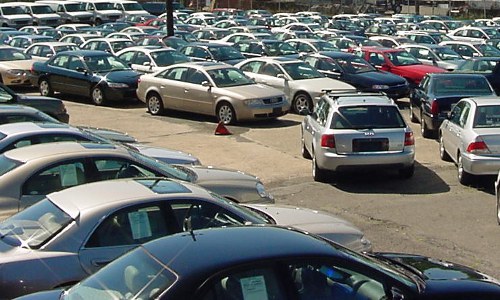For most of us, buying a car is the second largest financial commitment we’ll make in our lifetime. So naturally, we all want to get the best deal possible for our dollar! If you’re looking for used cars for sale, an auction can be a great way to pick up a quality new set of wheels, often at a bargain price.

Here are a few easy steps to follow to ensure your visit to the auction yard is a great experience:
1: Think about your requirements
Don’t go rushing in – before you even check out the auction times, you’ll need to decide what kind of vehicle is going to suit your lifestyle and needs. Take into consideration the main things you’re going to be using the car for, and what features you can and can’t compromise on.
For starters…
Size: If you’re mainly going to be travelling short distances to and from work, something compact should do you nicely (and help save on your petrol bill). On the other hand, if you’re constantly travelling out of town or need to fit your fishing gear or skis in the back, you’re going to want something roomier.
Safety: The newer the vehicle, the more safety features it’s likely to have. Nearly all cars on the market nowadays are likely to have ABS brakes and driver/passenger airbags, but you might only feel comfortable on the road with more advanced features such as side curtain airbags. Do your research into the various safety features available and decide which you want.
Practicality: If you’ve got kids and car seats to contend with, a coupe is quickly going to become a nightmare. Likewise, a monster SUV isn’t the best for an inexperienced driver. Do the thinking and save yourself hassle later on.
Engine type and size: Need to tow a boat? A 2.0 Liter 4 cyldiner probably isn’t going to cut it. And you might not need four-wheel-drive capability around the city, but if you’re likely to drive on country roads or visit the ski fields you might want to consider 4WD or AWD as a requirement. If you can drive a manual, remember that they’re often cheaper to both buy and maintain.
2. Decide on a budget
Pick an upper limit of what you’re prepared to pay for your new car, being realistic about what you can afford given your list of requirements. Many people choose to finance their purchase, although obviously you need to be careful here.
3. Do your homework
If you have a specific type of car in mind, it’s a good idea to research what similar models and years have sold for in the past, so you don’t get ripped off. eBay is a great place to check this out. If you’re in New Zealand, you can use Turners car valuation tool.
3. Choose a reputable auction company
When buying a second hand car, its rare that it will be in exactly the same condition as when it was new, and with so many mechanical parts, it’s very easy for something break or not work properly. That’s why it’s important to work through a reputable auction company that checks their cars before the auction, and who are willing to help should something go wrong, post-purchase.
4. Arrive with plenty of time
The auction yards generally open a couple of hours before auctions are due to begin, so make sure you’re down there as early as possible so you can test-drive the vehicles you’re interested in, carefully inspect them, and familiarise yourself with the auction process . It might pay to ask a friend or family member with some mechanical knowledge to come along too.
Don’t forget your driver’s licence; you’ll need it in order to carry out test drives!
5. Inspect the vehicle/s you’re interested in thoroughly
Right, you’re there in the auction yard, with a car you like the look of sitting in front of you. Now what?
Well, first up, have a look at the bodywork. Are any panels clearly out of alignment? A vehicle history report will usually tell you if a car has been imported as damaged, but it pays to look carefully all the same. Are areas of paint coloured slightly differently to the rest? These are signs of poor repair jobs and may indicate more significant underlying structural damage.
Next, pop the hood. Look for signs of oil leakage under the engine, scan for any signs of rust or wear and tear on the engine itself, and check the oil and water. Check the tyre tread. Test the head and brake lights, the air conditioning, the CD player, the central locking and the electric windows (if any).
Look inside the car’s interior for steering wheel and brake/accelerator pedal wear, upholstery tears, wear on the floor carpet (lift up the floor mats and look underneath) and any other flaws. There are likely to be a few imperfections on any second hand vehicles, but you need to ask yourself if you can live with them – or alternatively how much it will cost to repair the faults.
6. Inspect the vehicle/s you’re interested in even more thoroughly
This is a major purchase and you should carry out as many checks in order to protect yourself.
One possibility is to get a vehicle inspection report from one of the many online providers offering them. This will help you ensure the vehicle you’re looking at purchasing has genuine mileage and hasn’t been imported as damaged.
If you pre-arrange it and arrive with plenty of time to spare, it’s also possible to carry out your own pre-purchase inspection report – there are many companies that provide this service. Just keep in mind that this probably isn’t necessary with a reputable auction house who run their own checks.
7. Take it for a spin
Now it’s time to spend some time behind the wheel. Get the key and start ‘er up. Listen carefully – does the car run smoothly, or is the engine rattly or sound as though it’s struggling?
Next, drive the car around the test-drive track. Does it list to one side or the other? Does the wheel feel overly ‘heavy’ in your hands (this may indicate problems with power steering)? Does it turn corners well? How does it respond when you hit the accelerator or the brake? Quickly? Smoothly? Jerkily? If it’s a manual, how do the clutch and gearbox feel?
By the time you’re done, you’ll probably have a good idea whether the car ‘feels right’ in terms of handling. If all is well, it’s time to bid!
8. Remember to factor in your auction costs to the overall bid
It’s a good idea, before you sit down ready for the auction to begin, to factor in any associated auction costs to your budget. New imports often require an additional fee to be paid for the vehicle to be registered and warranted, and there’s a small extra cost required for the auction house’s services.
9. Stay calm
Right, bidding is about to kick off. Make sure you know where and when the car/s you are interested in buying are being auctioned, and that you have a good view of the auctioneer (make sure also that he/she can easily see you when you raise your hand!)
When the time is right, raise your bidding number sign. Listen carefully, and continue bidding as long as you feel comfortable. Remember to stick to your budget – emotions can sometimes run a bit high in an auction.
If you’re lucky, the hammer will fall, and you’ll have a brand new ride to take home.
10. Know your payment method
Most of the time, you’re required to pay the balance owing by the end of the day or arrange an appropriate finance deal. Make sure you’re able to do this – it may mean visiting a bank and coming back with the money (keep in mind that banks often place limits on how much can be spend on a debit card during a single day).
11. Enjoy
You’ve done the hard yards, researched your dream car, kept a cool head and come out of it all with something that will hopefully give you many years of hassle-free driving. Congratulations!




